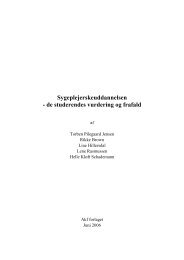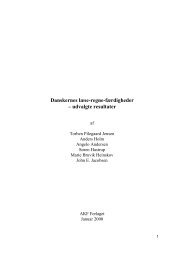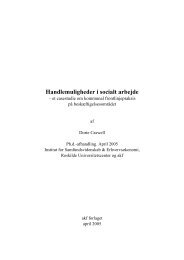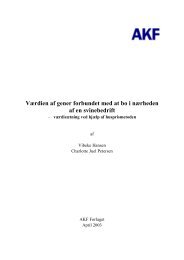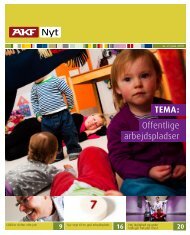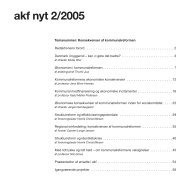Fremtidens ældre - Amternes og Kommunernes Forskningsinstitut
Fremtidens ældre - Amternes og Kommunernes Forskningsinstitut
Fremtidens ældre - Amternes og Kommunernes Forskningsinstitut
Create successful ePaper yourself
Turn your PDF publications into a flip-book with our unique Google optimized e-Paper software.
far below the national average in the Copenhagen metropolitan area and in<br />
the County of Aarhus (where there are large influxes of especially college<br />
students and where employment has been on the rise for the last decade).<br />
In contrast, the problems will be considerably greater in peripheral areas<br />
such as Bornholm and Lolland-Falster (as well as in South Jutland).<br />
The educational level of the elderly will increase. In 1990, two-thirds<br />
of 65-year-olds were unskilled, a quarter were skilled, while the last 10 per<br />
cent were college educated. In 2030, only 30 per cent will be unskilled, 45<br />
per cent skilled, and a total of 25 per cent will be college educated.<br />
The health of the elderly will also improve – many more will be able<br />
to care for themselves in their own homes (without outside help). Today, a<br />
70-year-old can do much more than a person of the same age could 20<br />
years ago. This has been the trend so far, and this is how it is expected to<br />
continue.<br />
Generally, the incomes of the elderly in Denmark are also expected to<br />
increase over the next few decades, as more and more people have paid<br />
into pension plans during their active working years.<br />
On the other hand, the disparity will be greater: the affluent pensioners<br />
will become steadily richer compared to those living off state pensions<br />
alone. The latter in particular, will be clearly left in the lurch by the income<br />
growth of the affluent pensioners.<br />
Increasing expenditure<br />
From 2000 to 2030, dem<strong>og</strong>raphic development alone will lead to an increase<br />
of approximately 23 per cent in public expenditure on the elderly.<br />
Increased transfer incomes make up 60 per cent of the growth, while services<br />
make up 40 per cent. Three-quarters of the growth is due to elderly<br />
people over 65. However, the increase in expenditure on the elderly is by<br />
no means the result of dem<strong>og</strong>raphy alone. A large proportion will come<br />
from increasing service standards and transfer incomes – this could, in fact,<br />
easily become the greatest problem.<br />
The elderly issue is not only a Danish phenomenon. On the contrary,<br />
the problems are even more pronounced in other OECD countries, such as<br />
Italy, Spain and Germany. In part, these countries experience greater<br />
68




